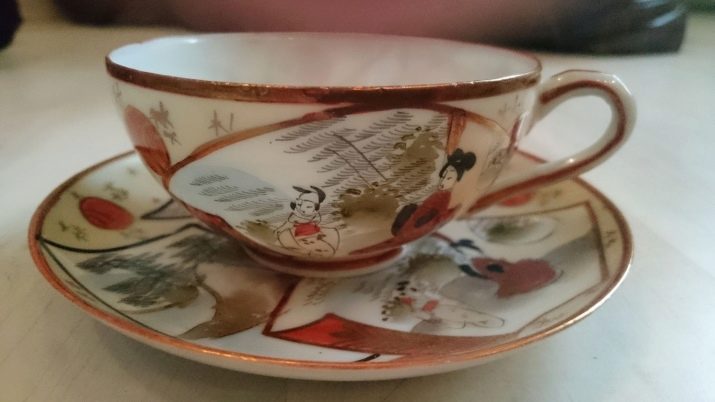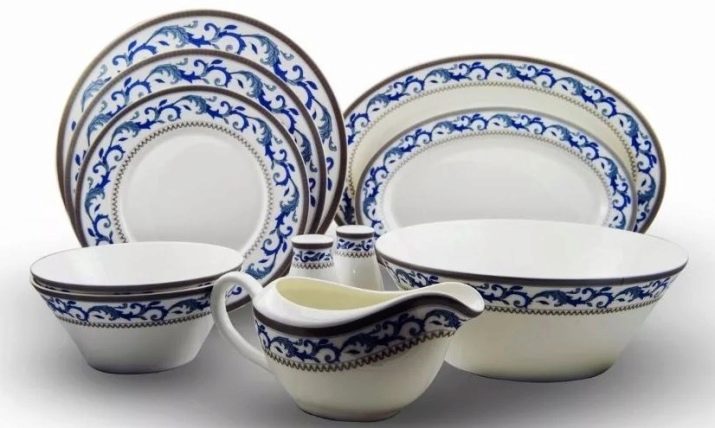Japanese porcelain: features and an overview of manufacturers

Dishes made of Japanese porcelain and ceramics are considered to be of the highest quality and most expensive. In this article, we will tell the history of products from Japan, consider the products of the most popular brands and give advice on the care and storage of items.

History of Japanese porcelain
Compared to China and Korea, Japan is relatively new to producing its own porcelain cutlery. Due to its high quality and beautiful design, Japanese porcelain has become one of the most popular in its niche. The first to discover the secret of Chinese porcelain were masters from Korea, who began to make it on their territory. The Japanese tried by all means to lure the Korean masters to their country so that they would teach the Japanese masters the art. Gradually, the first workshops began to appear in the country, producing quality goods from porcelain.

In the 16th century, the popularity of tea ceremonies began to grow, where it is important to observe a huge number of rules and know all the nuances. In accordance with ancient rituals, the choice of tableware also plays an important role. High society in Japan felt the need for appropriate products, so every year the volume of porcelain tableware made became more and more.
Until the beginning of the 19th century, porcelain cutlery and tea utensils were available only to the Japanese nobility, while the middle and lower classes used earthenware or wooden utensils. Later, all residents could acquire the noble material if they could afford it. Gradually, the country began to export its products to the West - coffee and tea sets were in great demand in European countries. Nowadays, china from the Land of the Rising Sun is easier to find in Europe and Russia than in Japan itself.


As for the style of the products, initially the masters copied the Chinese design, completely painting the whole item. Later, their own handwriting appeared, and Japanese porcelain products began to be painted with oriental motives. When the products were exported to the West, artisans decided to make the design of the products appropriate, adding some notes of originality to some products and leaving the classic restraint in others.

Nowadays, porcelain in the Land of the Rising Sun is produced and painted in several cities at once, each factory has its own characteristic handwriting and stamp, which is placed on the back of the products. The goods are made from bone china, to which ground animal bones are added. They give the material even greater strength and whiteness.
One of the main features of Japanese tableware is luxurious patterns, which are applied not only from the front, but also from the back.... On some cymbals, you can see a smooth transition from the main pattern to the purl. There are models where the pattern is applied only in the form of a contour.

Dinner sets and tea sets from Japan will be a wonderful gift for a loved one’s birthday or for a wedding. Any woman will be happy with such an expensive gift that will last for many years.
Product overview of popular brands
Japanese brands offer a wide range of bone china dining and tea sets for 6 and 12 people.

Narumi
The brand has long been a symbol of wealth and quality. Bone porcelain sets are very popular all over the world.

Nocturne
The crockery of this series is the embodiment of grace and sophistication. The items are hand-decorated with platinum decor. Embossed patterns with leaves and monograms give the snow-white fixtures a luxurious look. The table service for 6 persons can include 23 or 27 items:
- 6 plates for snacks;
- 6 plates for hot dishes;
- 6 deep soup bowls;
- salad bowl;
- salt shaker and pepper shaker;
- oval dish - 36 cm;
- round dish - 31 cm;
- tureen with a lid - 2.5 l;
- gravy boat with stand.
The cost of the set is 97,000 rubles.

A tea set for 6 persons consists of 17 items:
- teapot with lid - 940 ml;
- 6 cups;
- 6 saucers;
- milkman;
- sugar bowl with a lid.
The price of the set is 42,000 rubles.

Silk
The snow-white set is the embodiment of tenderness and accuracy. Curly edges and embossed patterns add originality and sophistication to classic tableware. Despite the lack of painting, the service looks very beautiful. The dining set for 6 persons consists of 27 items:
- 6 deep soup bowls;
- 6 dessert plates;
- 6 plates for main courses;
- 3 salad bowls;
- oval dish - 38 cm;
- round dish - 30 cm;
- sauce bowl with a stand;
- salt shaker and pepper shaker.
The price of a set of bone china is 70.320 rubles.

The tea set is also designed for 6 persons and contains 17 items:
- kettle with a lid - 1.2 l;
- sugar bowl with a lid;
- milkman;
- 6 cups;
- 6 saucers.
Price - 37,850 rubles.

Takito
Luxurious pieces add an eye-catching look to any table.

Sirius
Bone china dining and tea sets are designed for 6 persons. Additionally, you can purchase items to expand the set. Snow-white items are covered with platinum patterns and layering. The table service consists of 27 items:
- 6 plates for snacks;
- 6 plates for main courses;
- 6 deep soup bowls;
- soup tureen - 2.5 l;
- 2 salad bowls;
- oval dish - 31 and 36 cm;
- salt and pepper shaker;
- gravy boat with stand.

A set worth 43,000 rubles will decorate any table.
A tea set from the Sirius line costs 17,000 rubles and consists of 17 items:
- kettle with lid - 1.3 l;
- 6 cups;
- 6 saucers;
- milkman;
- sugar bowl with a lid.

Japonika
A brand with a long history produces tableware with both classic patterns and original ones.

Vanguard
Table and tea sets of this line are designed for 6 persons. White items have bright, colorful edging with colorful patterns that won't go unnoticed.The series will be a great gift for creative people who prefer original solutions in all areas. The table set consists of 26 items:
- 6 dessert plates;
- 6 plates for main courses;
- 6 deep soup bowls;
- dish - 34 cm;
- dish - 29 cm;
- dish - 24 cm;
- tureen with a lid;
- salad bowl.

The service price is 42,300 rubles.
If desired, it can be supplemented with other items.
A tea set worth 16,200 rubles consists of 17 items:
- teapot with lid - 940 ml;
- 6 cups;
- 6 saucers;
- sugar bowl with a lid;
- milkman.

Naomi
A beautiful and delicate set of dishes will be a wonderful gift for newlyweds for a wedding or engagement. It will take its rightful place in the window and will delight the eye every day. Against a snow-white background, blue patterns in the form of curls and monograms are clearly visible, gold layering along the edges of the edging gives the products a rich look. Table service "Naomi" consists of 26 items:
- 6 deep soup bowls;
- 6 plates for main courses;
- 6 plates for snacks;
- 3 salad bowls;
- oval dish - 31 cm;
- oval dish - 25 cm;
- sauce bowl.

The price of the kit is 38,700 rubles.
The tea set, worth 16,100 rubles, consists of 17 items:
- teapot with lid - 940 ml;
- sugar bowl with a lid;
- milkman;
- 6 cups;
- 6 saucers.

How to care?
In order for Japanese porcelain products to serve for many years, it is necessary to follow the rules for the care and storage of dishes. First of all, you should pay attention to the presence of patterns and gold or silver patina on the dishes. If they are present, you will have to abandon the use of a dishwasher and microwave, as high temperatures can negatively affect the quality of the painting. Aggregates will not do any harm to porcelain.

Hand washing can only be carried out using a soft sponge, since the metal version gradually erases the pattern. The detergent must be mild and free of abrasive substances. The modern household chemicals market offers products designed specifically for porcelain dishes. Remove the rings from your fingers, they can scratch the coating of plates and cups. You can wash devices made of noble material only in warm water... Wipe clean items with a soft kitchen towel.

If the dishes have lost their snow-white color, you can wipe them with a cotton pad dipped in tartaric acid. Dark tea or coffee marks on cups can be easily removed with soda solution or vinegar. It is recommended to store porcelain sets in cabinets or showcases. Between each plate, it is advisable to put a soft paper napkin, which will prevent scratches on the inner surface. If there is not enough space in the cabinet, you can put the dishes in a cardboard box, after wrapping each product in paper.

For information on how to distinguish Japanese porcelain from ordinary porcelain, see the next video.








